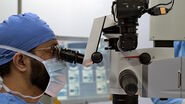Gene therapy surgical procedures require a high level of precision and pose specific challenges in pediatric patients. The use of intraoperative Optical Coherence Tomography (OCT) is essential to ensure correct bleb placement and manage potential complications.
Case Description
A 3-year-old Caucasian girl presented with the classic features of RPE65 disease: an early onset severe retinal dystrophy including light staring and nyctalopia. She was diagnosed with compound heterozygous mutations in the RPE65 gene. She had nystagmus, poor low illumination visual function and reduced photopic acuity.
Pre-operative assessment
The patient’s vision was 1.2 LogMAR and she was myopic. The pre-operative retinal fundus imaging showed mild vascular attenuation, normal macula volume, an intact ellipsoid, and no obvious dystrophy features. She had an absent electroretinogram (ERG) and her pattern visual evoked potential (pVEP) was significantly reduced.
Continue Reading
Want to discover how Mr. Henderson injected gene therapy under the retina utilizing intraoperative OCT on the Proveo 8 surgical microscope?
Complete the form to download the full case study.
Please note that off-label uses of products may be discussed. Please check with regulatory affairs for cleared indications for use in your region. The statements of the healthcare professionals included in this clinical case reflect only their opinion and personal experience and not those of Leica Microsystems. They also do not necessarily reflect the opinion of any institution with whom they are affiliated.






